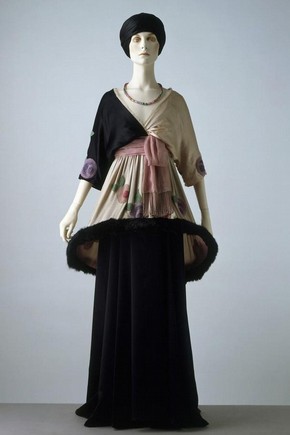And I thought I couldn't keep up a couple centuries ago! Fashion began evolving faster than ever before. Cultures crossed, history repeated, and designs were more accessible and spreadable through the development of printing and photography. Hold on tight!
 |
| A girl can't have too many blouses! Or can she? |
By the time we were well into the 20th century, fashion is certainly not what it used to be. It was all about the designer innovation. Women's fashion gradually changed with slimmer silhouettes- this means no more bustles, petticoats, or those darned crinolines!. The
S-curve silhouette was desired by the fashion-conscious woman. The not-so-comfy corset was replaced with the "
health corset", which alleviated pressure from the ribs and waist and instead thrust the bosom forward and the hips back, creating the S-curve figure.
 |
| The desired S-curve figure |
Women would dress their S-curve figures with long, heavy skirts and flouncy lace
blouses. Later women wore suits with tailored blouses and skirts for the "New Woman" look.
 |
| Paul Poiret, 1912 |
The early 20th century saw the rise of
haute couture and Paul Poiret. He designed loose-fitting gowns and
hobble skirts with tunics to create the "lamp shade effect". Poiret also drew inspiration from "oriental" motifs and designs. "...less hips... how slim, how graceful, how elegant..."
 |
| Flapper girl in flapper dress, boa, and pearls. |

The
flapper era stretched through the '20s and '30s when the silhouette was much more relaxed, and so was the woman! Women wore closely fitting garments with
short skirts and
low waistlines, as well as
pants and long dresses with pleats. In 1925, the
shift dress was introduced with no waistline at all.
Rayon stockings became a staple in a 1920s girl's wardrobe. The flapper dress was often made with lots of fringe.
 |
| Watch out! Loose women! |
 |
| The LBD |
The '20s are to thank for the
Little Black Dress, made popular by Coco
Chanel. The LBD was said to be "Chanel's Ford" because it was popular and as indispensable as Ford's cars.
 |
| Cloche hat |
The most popular hairstyle was the
bob, and
cloche hats were all the rage. Women also wore headbands and pearls with their dresses.
Among other styles in the '20 were ankle-length skirts,
tailored suits, short dresses with full skirts, and
sweaters.
 |
| Popular women's suits |
 |
| Long, slim silhouettes of the '30s |
In the '30s,
Hollywood dominated the fashion world. Women wore tailored, belted
chiffon dresses and backless,
long-line dresses along with simple wrap coats and
furs. Feminine curves were accentuated through the emergence of
bias-cut dresses. Evening dresses had long, leg of mutton sleeves,
halter necklines, and high-necklines. Hair was short and waved,
makeup was better than ever, and
gloves and hats were all the rage!
 |
| Dior's New Look suit |
By the mid-'40s fashion was back from the war and trends were dictated by des
igners such as Christan Dior and Cristobal Baleciaga. Dior's signature look featured a mid-calf length skirt, pointed bust, small waist, and rounded shoulder line.
Halter-top
sundresses with full skirts,
shirtdresses, and
poodle skirts all became popular and the cocktail dress was worn for parties.
 |
| Poodle skirts were popular among teens |
 |
| Popular shirtdress pattern |
 |
| Halter neck garments |
 |
| The signature Chanel suit was introduced in the '50s, as well as trousers, houseboy pants, and Bermuda shorts. |
 |
| "Sure, Johnny! That'd be swell!" |
Throughout the era of the New Look hair was cut short and curled and topped with hats such as the saucer hat. Later on, the poodle cut became popular and was followed by the bouffant and beehive styles.




 The flapper era stretched through the '20s and '30s when the silhouette was much more relaxed, and so was the woman! Women wore closely fitting garments with short skirts and low waistlines, as well as pants and long dresses with pleats. In 1925, the shift dress was introduced with no waistline at all. Rayon stockings became a staple in a 1920s girl's wardrobe. The flapper dress was often made with lots of fringe.
The flapper era stretched through the '20s and '30s when the silhouette was much more relaxed, and so was the woman! Women wore closely fitting garments with short skirts and low waistlines, as well as pants and long dresses with pleats. In 1925, the shift dress was introduced with no waistline at all. Rayon stockings became a staple in a 1920s girl's wardrobe. The flapper dress was often made with lots of fringe.











No comments:
Post a Comment